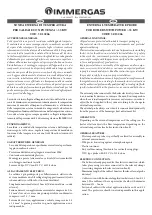
14
HD25Bi 22/09/15
the flames disappear and there are still lumps of solid wood left this indicates excessive moisture in the
wood or insufficient air supply/flue draught.
Note:
To eliminate unwanted smoke emission, after loading new logs on to the fire, open the air wash
control up fully for 1-2 minutes to boost the fire and get flames issuing from the top of the fuel as soon as
possible. When flames are well established, reduce the air wash to the running setting required. Burning
without flames above the fuel will create unnecessary smoke. Do not operate the appliance with the air
controls fully open for a prolonged period as it will cause over firing and may result in smoke being
produced.
Loading 1 to 2 medium sized logs will produce a good output with reasonable burn time, generally small
logs will burn up quicker producing a high output for a short time and a large log will take longer to burn
and produce less output over a given time. These appliances are approved for intermittent operation on wood
(0.75 to 1.5 hour burn cycles) although much longer burn times can be achieved by fully loading the firebox,
getting the fuel burning well and then shutting the air controls down. The fire will then often need reviving
by first de-ashing and then using small pieces of wood and plenty of air to get flames issuing from the wood
again.
Refuelling on to a low fire bed
If there is insufficient burning material in the fire bed to light a new fuel charge, excessive smoke emission
can occur. Refuelling must be carried out onto a sufficient quantity of glowing embers and ash that the new
fuel charge will ignite in a reasonable period. If there are too few embers in the fire bed, add suitable
kindling to prevent excessive smoke
Fuel Overloading
Four good size logs is a sufficient quantity of fuel to achieve the rated output from this appliance. Never
exceed this amount of fuel and never stack the fuel too high in the stove so as it touches the baffle or blocks
the tertiary air holes as this may cause smoke to be produced.
Shutting Down
The stove will normally shut down by itself as the fuel is consumed. In order to shut down the stove for
other reasons, close the primary air controls (if open), then close the secondary air control. If the controls are
left in this position, the fire will eventually burn out. If you want to revive the fire open the secondary air
controls fully.
Warning! -
The stove will remain
very hot
for a considerable time after the fire has died down or been
extinguished.
Warning!- Petroleum coke fuels or household waste must not be burnt on this appliance.
Seasonal Use
Remove the baffle and inspect the inside of the stove and the flue ways and ensure they are 100% clear after
a period of disuse, for example if the stove is not used during the warmer periods of the year. Also set the air
controls to 50% to keep the appliance ventilated and stop the build-up of any moisture inside.
Maintenance
Inspect the inside of the firebox and above the baffle plate every week during use.
See chimney cleaning
section in section 3.1 Warnings and Important Information.
Inspect the inside of the stove and the flue
ways and ensure they are 100% clear after a period of disuse (e.g summer).
Only use manufacturers
recommended replacement parts on the appliance (see page 19 for full list of spare parts).







































